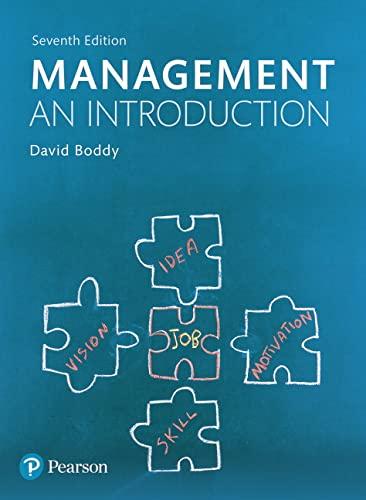Question
Direction: Read the article below and short reaction about this regarding cost of quality in manufacturing. GLOBAL PRODUCTION NETWORK PLANNING AT CATERPILLAR INC. (Adopted fromwww.ifm.eng.cam.ac.uk>
Direction:Read the article below and short reaction about this regarding cost of quality in manufacturing.
GLOBAL PRODUCTION NETWORK PLANNING AT CATERPILLAR INC.
(Adopted fromwww.ifm.eng.cam.ac.uk> Resources)
Caterpillar Inc. Is the largest maker of construction and mining equipment, diesel and natural gas engines and industrial gas turbines in the world. It requires a global production network that can serve ever-changing market dynamics, while maintaining world-beating standards of cost, quality, service and flexibility. Rod Skewes, Caterpillar's Manager of Global Production Network Planning, describes their approach, developed in collaboration with Cambridge University.
This project has been a long journey, and, as with most epic journeys, it has not been without its travails. Working with Cambridge's Institute for Manufacturing (IfM) since 2003, the company has now successfully developed and embedded a comprehensive strategic process across a large, complex organization, compromising10 different business divisions and more than 30 separate product groups. The process has thrown up a number of challenges, all of which have been overcome - a tribute to the firm's 'get it done' attitude. Skewes explained the reasons behind the project: "We are one of the world's largest manufacturers, with sales approaching $50bn, and the main reason for starting this process was to secure the long-term optimization of our production network. Over time the 'burning platform' has changed but the process remained the same, allowing us to constantly update the vision as conditions evolve. This vision then serves to guide and align all our investment regarding the future footprint."
The Caterpillar vision Caterpillar worked with IfM Education and Consultancy Services (IfM ECS) to co-develop the process during 2003-5 based on concepts emerging from IfM research. The company's main goals, as outlined by Fred Mason (then director of Product Source Planning) were to achieve:
- Improved alignment with projected sales.
- Improved return on production-related assets.
- Increased enterprise synergies.
Under Mr. Skewes leadership, the company then deployed the approach across all business and product groups during 2005-2008, resulting in a combined 'blueprint' for the whole enterprise. This was followed by a fine-tuning and embedding phase during 2009-10, during which major projects were launched. Skewes said: "Essentially the program has always been about building on current success to secure the long-term future of the business. In the middle of the project we moved from record growth to one of the worst global recessions in recent times. "Like most industries, we didn't foresee the magnitude of the downturn and, having started with a backdrop of severe under capacity, the issues suddenly became the exact opposite. It's important to note that the vision never changed, the core objectives always remained the same, and the process remained robust."
Skewes, who has worked at Caterpillar for 24 years, said the process had thrown up some interesting observations, not least the need to have a constant and coherent vision and process even if the responses to it needed to be flexible.
"Caterpillar has always been a 'get it done' company, but this has tended to give us a short term outlook. It was sometimes difficult to get people to think about the long-term. We also have a very complex, manufacturing network and an extremely diverse product range."
We have defined around 600 product families ranging from our construction equipment to components and individual parts. Our products range from trucks that are bigger than a house to small machined parts smaller than your hand. "Coupled with this are the different production runs (ranging from hundreds to tens of thousands) and also different regulatory frameworks in different territories. These varying local operating environments make it difficult for our teams to act globally."
"Another key point was that we had to provide quantitative reasons for doing it. We constantly need to show that we are managing corporate resources effectively."
Mr. Skewes, who has been running the project for the last 6 years, said the company had learned a number of key lessons:
- Having a champion "You need a strong supporter in order to embark on a project like this. Within Caterpillar it was our CFO who provided unbending support and guidance."
- Top down support "There has to be top down support to achieve the cultural shift you need. Without it, you don't obtain the level of engagement required and the project just falls apart."
- Have a good financial model "The finance is really critical. Caterpillar is heavily populated with engineers and accountants, so you need solid quantitative evidence. A 2x2 matrix is easily shot down. Within our culture you need something hard and fast. You also need the analysis to be transparent so that people can understand the key drivers."
- Have a broad process "You also need a holistic approach that engages the management team and includes their broader strategic objectives."
- Involve the right people "It's important that you get everyone through the process and on the same page. We made a conscious decision to include as much of Caterpillar as we could."
- Train the organization to think strategically "As an organization, we make products to sell and make profit. But we also need to think more strategically and long term. You're going to get push back at first, but you need that buy in, you need the time to explain it.
DIRECTION:REFLECTION ABOUT THIS ARTICLE
Step by Step Solution
There are 3 Steps involved in it
Step: 1

Get Instant Access to Expert-Tailored Solutions
See step-by-step solutions with expert insights and AI powered tools for academic success
Step: 2

Step: 3

Ace Your Homework with AI
Get the answers you need in no time with our AI-driven, step-by-step assistance
Get Started


